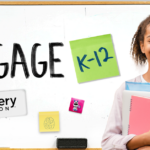By Dr. Rachel Brown Ph.D., NCSP | Originally published in the June/July 2020 issue of AC&E/Equity & Access
An estimated 14.8 million children in the US are affected by learning and attention issues, which when left undiagnosed can lead to challenges both inside and outside of school.
The National Center for Learning Disabilities recommends that schools use multi-tiered systems of support (MTSS) to identify and support students who may have a learning disability. I agree wholeheartedly – there’s incredibly value of having a MTSS in place – provided the right goals are being set.
With that in mind, here are three guidelines for creating reachable goals for students with learning disabilities:
Identify the need
Students who have fallen below grade-level expectations need additional support to improve and catch up to peers. The exact amount and type of additional instruction depends on the specific challenges that each student is encountering.
MTSS ensures every student is being supported and has growth goals set. When creating goals for students, it’s important to consider two questions:
- How much growth is needed to catch up to peers?
- Are the goals we’re setting realistic, or ambitious?
Having a system that supports accelerated growth for students who need is essential. Without a way to provide quick growth, students can be prone to the “Matthew Effect,” a term coined by Keith Stanovich that denotes the idea that once students fall behind, they aren’t likely to experience as much success as their classmates who are at (or above) grade level.
Let’s consider reading levels. Students who learn to read easily without extra support are more likely to enjoy reading and continue to see success reading. But, students who struggle with reading are more likely to dislike reading and avoid it, thus continuing to experience literary poverty.
To avoid the Matthew Effect, schools need to address students’ reading problems as soon as they are known and focus on “catch-up” growth. Catch-up growth refers to the growth needed for students who fall behind, which occurs at a faster rate than grade-level peers. This accelerated growth strategy ensures students can master missing skills and reach proficiency in core subject areas.
Set realistic objectives
Many students with learning disabilities are placed on an Individualized Education Plan (IEP). Goals included on a student’s IEP should be SMART (Specific, Measurable, Use Action Words, Realistic and Time-limited). Special Education Consultant Dr. Ruth Heitin shares that goals should be written in a way that describes what we hope a student will achieve, and measured through regular assessments.
A student’s rate of improvement (ROI) varies according to the type and amount of instruction. Consider the impact of consistency on student reading growth: a report from the National Reading Panel states reading instruction that is direct, systematic and provided every day is likely to result in a larger ROI than incidental teaching.
Given this link, educators should strive to create goals that align with a student’s level and actual time in the classroom. Some digital platforms automate this process, screening and predicting student growth so that teachers can select goals that are attainable.
Students with learning disabilities need ample time to reach proficiency. Monitoring progress and adjusting supports are key to making progress.
Monitor progress regularly
Progress monitoring is just as important as setting reachable goals. Progress monitoring needs to occur often enough for educators to review student data and adjust instruction, if it’s needed.
For students with learning disabilities, weekly progress monitoring is recommended. Assessments such as Curriculum-Based Measures in Reading (CBM-R) can be delivered quickly and frequently, so less time is taken away from instruction.
To know if a student is making enough progress, data needs to be reviewed regularly. For this to happen, enough data points need to be available to assess. Research suggests that at least 10 to 12 assessment scores are needed before progress data can be interpreted.
In 2018, a new method was developed by researchers Christ and Desjardins to calculate the trend and expected direction of future student growth. Using Bayesian statistics, their method predicts a student’s future growth with as few as six data points.
Student progress can vary for a number of reasons, so it’s best practice to review progress data every four to six weeks to see if the student is on track to meet their goals, or if an instructional change is needed.
Although students with learning disabilities are prone to experiencing challenges when attaining important skills, such as reading, there are research-backed ways to help them succeed. With direct, consistent instruction and regular progress monitoring, every student can remain on track for success, and achieve their goals.
Dr. Rachel Brown taught social studies and history, as well as special education, for 10 years prior to earning her Ph.D. in special education and school psychology at the University of Massachusetts, Amherst. She was on the faculty at USM from 2000-2016 in the Educational and School Psychology Department and now teaches in the Special Education Department. Her research focuses on effective instructional practices and Response to Intervention (RTI) and Multi-Tier Systems of Support (MTSS). Dr. Brown is a Maine certified special educator, school psychologist, and licensed psychologist.
The American Consortium for Equity in Education, publisher of the "Equity & Access" journal, celebrates and connects the educators, associations, community partners and industry leaders who are working to solve problems and create a more equitable environment for historically underserved pre K-12 students throughout the United States.
- American Consortium for Equity in Educationhttps://ace-ed.org/author/admin/
- American Consortium for Equity in Educationhttps://ace-ed.org/author/admin/April 23, 2025
- American Consortium for Equity in Educationhttps://ace-ed.org/author/admin/
- American Consortium for Equity in Educationhttps://ace-ed.org/author/admin/







